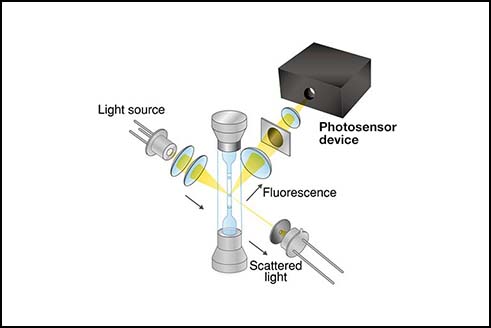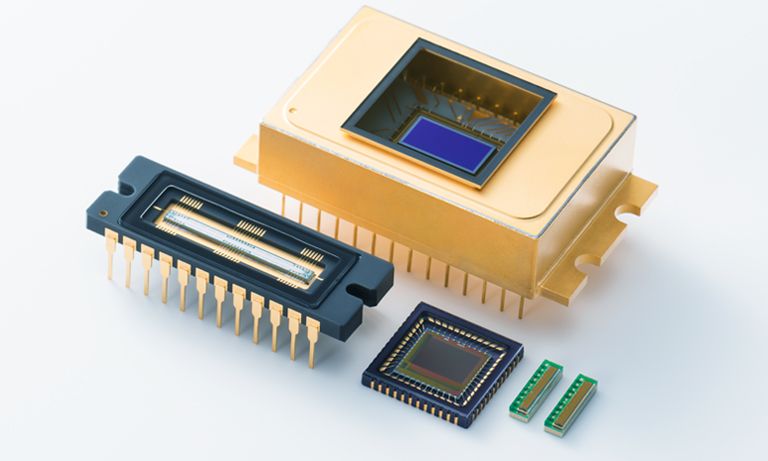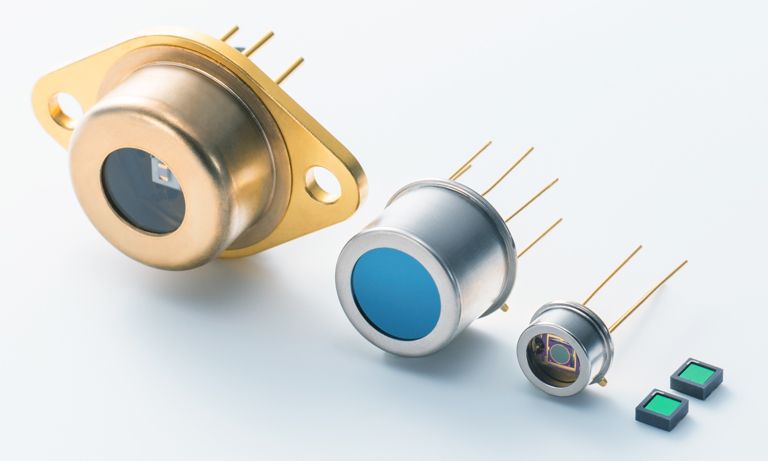Application notes
Technical notes
Ask an engineer
Publications
United States (EN)
Select your region or country.
PMT Questions & Answers
- When looking at your PMTs, I see that there are some “P” types and regular types. What’s the difference?
- Thanks for the info. What about the PMT modules? I heard that there’s a P type module and even a PA type module. What’s the deal?
- Wait a minute, what about the PA type I hear so much about?
- I see Hamamatsu offers associated components for photomultiplier tubes (PMTs). In particular, what is the difference between D-type and DP-type socket assemblies for PMTs?
- Can I use any socket assembly with my PMT?
- OK, so Hamamatsu offers PMTs and also corresponding sockets to pair with them. Are there any offerings that include a PMT and these associated components all in one package?
When looking at your PMTs, I see that there are some “P” types and regular types. What’s the difference?
Well, I’m glad you asked. The P (like in R1924P) stands for “photon counting” type. When producing PMTs, you can get a typical production distribution for a number of different PMT characteristics. Two characteristics that are specifically important for photon counting applications (where you use a photon counting circuit and a counter) are gain and dark counts. The “P” type PMTs are selected out of the distribution for lower than average dark counts. In some cases, often with head-on PMTs, the “P” type PMTs are selected for higher than average gain as well. The high gain helps you set your threshold level for the lower level discriminator in the photon counting circuit. The low dark counts help you achieve good signal-to-noise ratio (SNR) even at low photon levels (see the equation in a previous Q&A). So really, the difference is that “P” types are selected out of the distribution for good photon counting characteristics.
Thanks for the info. What about the PMT modules? I heard that there’s a P type module and even a PA type module. What’s the deal?
We have a few different types of PMT modules.
- Current Output Type: This is a PMT and a voltage divider circuit with a high voltage transformer. So it only needs low voltage (5-15 V) for operation. These can come in “P” type where the PMT inside is selected for photon counting as mentioned above. These can be used with a photon counting circuit.
- Voltage Output Type: These modules are the same as above and also have a current-to-voltage amplifier. Because there’s an amplifier already built-in and you need specific amplifiers for photon counting, we typically do not have “P” designations for them.
- Photon Counting Type: These PMT modules are the whole kit and caboodle! They have the PMT (P Type) with the voltage divider socket and the photon counting circuit. The output of these modules are logic pulses which can go right into the counter! The added bonus is that the gain/voltage of the PMT is already set for perfect photon counting. No adjustment is needed; you can just start counting!
Wait a minute, what about the PA type I hear so much about?
Man, you’re sharp! For some modules, specifically modules with a GaAsP/GaAs photocathode, we have what’s called “PA” type. The P still stands for photon counting as above. The extra A stands for AWESOME. Just kidding, the extra A is a designation that the protection circuit in the module has been changed. The protection circuit monitors the average signal current from the PMT. The GaAsP/GaAs photocathodes are particularly sensitive to high light levels. The protection circuit is put in place so that when the signal output current reaches a specific value (which relates to the amount of light on the photocathode), the PMT voltage shuts down or an alarm goes off.
More specifically, once the PMT current reaches 5-10 µA for a time period of ~100 µs, the protection circuit is triggered. It takes ~150 ms for the protection circuit to turn off the power to the PMT. Once this has occurred, it takes ~5 seconds for the module to recover. Turn the module off and back on to reset the protection circuit and use the PMT again.
We find for some applications (like multiphoton microscopy), it is OK for there to be sudden (and few) high peaks of current. In these cases, we increase the protection circuit current value of the PMT module from 5-10 µA to ~50 µA. We do this because while some sudden pulses may be high, the average current is still low, and therefore the PMT is still safe. So, the H7422PA-40, for example, is a PMT module with an increased protection circuit from 5-10 µA to ~50 µA.
Also, these modules with protection circuits can be modified to not include the protection circuit at all. Please inquire with our engineers to learn more about these options!
I see Hamamatsu offers associated components for photomultiplier tubes (PMTs). In particular, what is the difference between D-type and DP-type socket assemblies for PMTs?
D-type sockets contain a resistive divider network needed to distribute the applied high voltage across the PMT dynodes. DP-type sockets also contain this same resistive divider network, in addition to a high voltage power supply built into the socket that transforms low voltage to the high voltage required for the PMT. This allows users to operate the PMT using 5 or 15 volts depending on the model.
Can I use any socket assembly with my PMT?
Not every socket is the same! Each PMT has corresponding compatible socket assemblies. The matching socket assembly, if available, for any PMT can be found listed in our photomultiplier tubes catalog. Also, each PMT may have multiple socket assemblies available for a desired characteristic: for example, the divider may be different for high pulse linearity vs. DC linearity, etc. If you need any help selecting, please feel free to give us a call.
OK, so Hamamatsu offers PMTs and also corresponding sockets to pair with them. Are there any offerings that include a PMT and these associated components all in one package?
Why yes! Hamamatsu also offers PMT assemblies and modules. A PMT assembly integrates both a Hamamatsu PMT and resistive divider network (D-type socket assembly) into one package. They can often come with HA coating, magnetic shielding, or cases or connectors which house the PMT and socket assembly together.
All PMT modules will contain, at least, a PMT, resistive divider network, and high voltage power supply in one package. In addition, there are some module offerings that may also include amplifiers, thermoelectric cooling, and PC interfacing.
If you have a technical question you’d like to see answered on this page, email us.
Meet the engineers

Eric Mesa is an Applications Engineer out of NJ, who understands the intricacies of signal-to-noise comparisons. He likes baseball and most other sports, and when it comes to detector selection, he always hits a home run!

Kate Pritchard has gone where no applications engineer has gone before...in managing the newly formed University Support Group. The group is dedicated to supporting our research and academic customers through technical support, collaborations, and face time. Traveling at the speed of light to explore strange and exciting new worlds for Hamamatsu! (See what I did there...)
- Confirmation
-
It looks like you're in the . If this is not your location, please select the correct region or country below.
You're headed to Hamamatsu Photonics website for US (English). If you want to view an other country's site, the optimized information will be provided by selecting options below.
In order to use this website comfortably, we use cookies. For cookie details please see our cookie policy.
- Cookie Policy
-
This website or its third-party tools use cookies, which are necessary to its functioning and required to achieve the purposes illustrated in this cookie policy. By closing the cookie warning banner, scrolling the page, clicking a link or continuing to browse otherwise, you agree to the use of cookies.
Hamamatsu uses cookies in order to enhance your experience on our website and ensure that our website functions.
You can visit this page at any time to learn more about cookies, get the most up to date information on how we use cookies and manage your cookie settings. We will not use cookies for any purpose other than the ones stated, but please note that we reserve the right to update our cookies.
1. What are cookies?
For modern websites to work according to visitor’s expectations, they need to collect certain basic information about visitors. To do this, a site will create small text files which are placed on visitor’s devices (computer or mobile) - these files are known as cookies when you access a website. Cookies are used in order to make websites function and work efficiently. Cookies are uniquely assigned to each visitor and can only be read by a web server in the domain that issued the cookie to the visitor. Cookies cannot be used to run programs or deliver viruses to a visitor’s device.
Cookies do various jobs which make the visitor’s experience of the internet much smoother and more interactive. For instance, cookies are used to remember the visitor’s preferences on sites they visit often, to remember language preference and to help navigate between pages more efficiently. Much, though not all, of the data collected is anonymous, though some of it is designed to detect browsing patterns and approximate geographical location to improve the visitor experience.
Certain type of cookies may require the data subject’s consent before storing them on the computer.
2. What are the different types of cookies?
This website uses two types of cookies:
- First party cookies. For our website, the first party cookies are controlled and maintained by Hamamatsu. No other parties have access to these cookies.
- Third party cookies. These cookies are implemented by organizations outside Hamamatsu. We do not have access to the data in these cookies, but we use these cookies to improve the overall website experience.
3. How do we use cookies?
This website uses cookies for following purposes:
- Certain cookies are necessary for our website to function. These are strictly necessary cookies and are required to enable website access, support navigation or provide relevant content. These cookies direct you to the correct region or country, and support security and ecommerce. Strictly necessary cookies also enforce your privacy preferences. Without these strictly necessary cookies, much of our website will not function.
- Analytics cookies are used to track website usage. This data enables us to improve our website usability, performance and website administration. In our analytics cookies, we do not store any personal identifying information.
- Functionality cookies. These are used to recognize you when you return to our website. This enables us to personalize our content for you, greet you by name and remember your preferences (for example, your choice of language or region).
- These cookies record your visit to our website, the pages you have visited and the links you have followed. We will use this information to make our website and the advertising displayed on it more relevant to your interests. We may also share this information with third parties for this purpose.
Cookies help us help you. Through the use of cookies, we learn what is important to our visitors and we develop and enhance website content and functionality to support your experience. Much of our website can be accessed if cookies are disabled, however certain website functions may not work. And, we believe your current and future visits will be enhanced if cookies are enabled.
4. Which cookies do we use?
There are two ways to manage cookie preferences.
- You can set your cookie preferences on your device or in your browser.
- You can set your cookie preferences at the website level.
If you don’t want to receive cookies, you can modify your browser so that it notifies you when cookies are sent to it or you can refuse cookies altogether. You can also delete cookies that have already been set.
If you wish to restrict or block web browser cookies which are set on your device then you can do this through your browser settings; the Help function within your browser should tell you how. Alternatively, you may wish to visit www.aboutcookies.org, which contains comprehensive information on how to do this on a wide variety of desktop browsers.
5. What are Internet tags and how do we use them with cookies?
Occasionally, we may use internet tags (also known as action tags, single-pixel GIFs, clear GIFs, invisible GIFs and 1-by-1 GIFs) at this site and may deploy these tags/cookies through a third-party advertising partner or a web analytical service partner which may be located and store the respective information (including your IP-address) in a foreign country. These tags/cookies are placed on both online advertisements that bring users to this site and on different pages of this site. We use this technology to measure the visitors' responses to our sites and the effectiveness of our advertising campaigns (including how many times a page is opened and which information is consulted) as well as to evaluate your use of this website. The third-party partner or the web analytical service partner may be able to collect data about visitors to our and other sites because of these internet tags/cookies, may compose reports regarding the website’s activity for us and may provide further services which are related to the use of the website and the internet. They may provide such information to other parties if there is a legal requirement that they do so, or if they hire the other parties to process information on their behalf.
If you would like more information about web tags and cookies associated with on-line advertising or to opt-out of third-party collection of this information, please visit the Network Advertising Initiative website http://www.networkadvertising.org.
6. Analytics and Advertisement Cookies
We use third-party cookies (such as Google Analytics) to track visitors on our website, to get reports about how visitors use the website and to inform, optimize and serve ads based on someone's past visits to our website.
You may opt-out of Google Analytics cookies by the websites provided by Google:
https://tools.google.com/dlpage/gaoptout?hl=en
As provided in this Privacy Policy (Article 5), you can learn more about opt-out cookies by the website provided by Network Advertising Initiative:
http://www.networkadvertising.org
We inform you that in such case you will not be able to wholly use all functions of our website.
Close















